Warby Parker is a mission-driven eyewear retailer founded in 2010 and headquartered in New York City. The company’s mission is to “inspire and impact the world with vision, purpose, and style,” offering designer-quality eyewear at affordable prices.
Warby Parker began by selling prescription glasses online for a flat $95 (including lenses), disrupting an industry long dominated by a monopoly that kept prices high. The company has since expanded to 300+ retail stores (as of 2025) across the U.S. and Canada, while maintaining a robust e-commerce presence.
Its core products include prescription eyeglasses, sunglasses, contact lenses, and eye exams/vision tests. Warby Parker has experienced rapid growth, from first-year sales targets met in three weeks to $771 million in revenue by 2024, and today holds roughly 7% of the U.S. eyewear market.
It positions itself as a trendy, tech-enabled alternative to legacy players like Luxottica (owner of LensCrafters) and online discounters like Zenni Optical.
Key highlights of Warby Parker’s trajectory include the Home Try-On program, achieving extremely high customer satisfaction (Net Promoter Score ~83 vs industry ~30), and proving that a for-profit business can scale while pursuing social good (over 15 million pairs donated via its Buy a Pair, Give a Pair program).
The company went public in 2021 and, after an initial stock surge, faced the reality of investor expectations for profitability.
By 2023, Warby Parker had improved margins and was nearing break-even, illustrating lessons in balancing growth with sustainable financials.
Major takeaways from Warby Parker’s story include the importance of industry disruption through innovation, the power of an omnichannel strategy (integrating online and offline retail), and the value of a strong brand built on customer experience and social mission.
Other businesses can learn from Warby Parker’s ability to reimagine a customer experience in a stagnant industry, scale it with a blend of technology and physical presence, and adapt strategy in response to market feedback, all while staying true to its founding vision of accessible, fun, and socially conscious commerce.
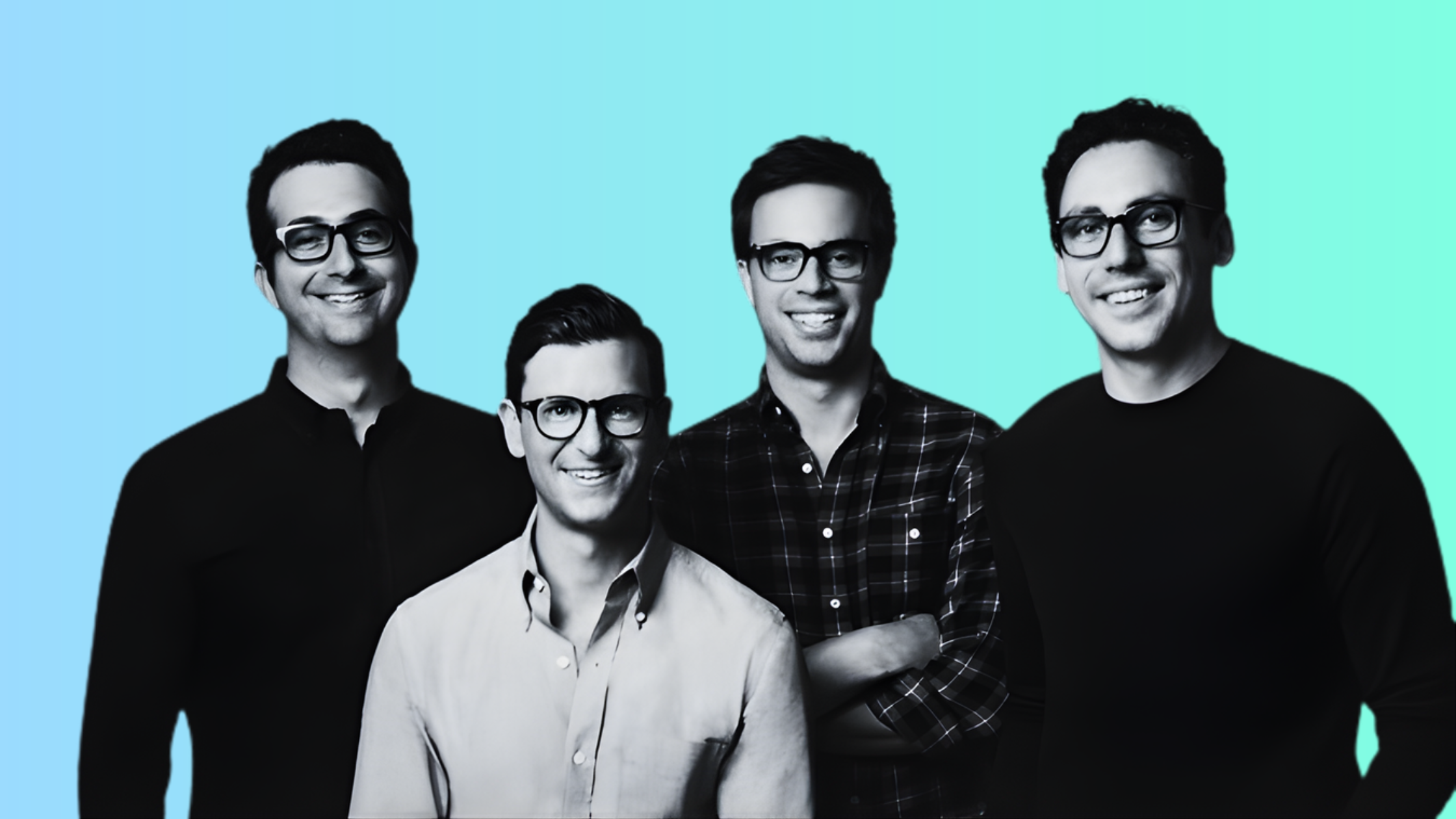
Company Background & History
Founding story
Warby Parker was founded in 2010 by four friends - Neil Blumenthal, David Gilboa, Andrew Hunt, and Jeffrey Raider, while they were MBA students at Wharton.
The idea was born out of personal frustration: one of the founders lost his glasses on a backpacking trip and couldn’t afford to replace them, spending a semester squinting without glasses.
They realized that glasses were exorbitantly priced due to industry consolidation (a single company, EssilorLuxottica, dominated the market).
The founders’ vision was to create an alternative: by designing eyewear in-house and selling directly to consumers, they could offer stylish prescription glasses for a fraction of the going price.
They also imbued the venture with a social mission from day one – for every pair sold, one would be distributed to someone in need (initially via nonprofits like VisionSpring, where co-founder Blumenthal had previously worked).
The company name “Warby Parker” comes from two characters in a Jack Kerouac journal, reflecting the literary and quirky brand ethos.
Warby Parker officially launched in February 2010 online, with its headquarters later established in New York City.
Early traction
Upon launch, Warby Parker’s concept quickly went viral. The founders had planned a slow ramp-up, but a feature in GQ and Vogue that year labeled Warby “the Netflix of eyewear” drove a flood of interest.
They hit their first-year sales target in just 3 weeks and sold out of their top 15 styles in 4 weeks. A waitlist of 20,000 accumulated as the startup scrambled to produce more inventory.
Those early months were chaotic, but the team responded in a notable way: the founders and first employees personally emailed and called every customer on the waitlist and even invited local customers to their apartment to try on the few sample frames they had left.
This high-touch customer care turned a potential backlash into a loyalty-building moment, setting the tone for Warby Parker’s customer-centric culture.

Timeline of major milestones:
- 2010: Warby Parker launches online in Feb. 2010, offering Home Try-On (5 frames by mail, free) – a novel concept in eyewear e-commerce. In the first year, over 100,000 pairs sold and 60 employees hired.
- 2011: Raises first outside funding: a $2.5 million seed and then a $12.5 million Series A led by First Round Capital and Tiger Global. Warby Parker’s annual sales hit $1 million by year’s end and it ships its 100,000th pair of glasses.
- 2013: Opens its first physical store in SoHo, NYC (after experimenting with pop-up shops and even a traveling “Class Trip” school bus store in 2012). The immediate success of the flagship leads Warby to plan more stores. Also launches an in-house point-of-sale system to sync online/offline inventory by 2015.
- 2015: Raises $100 million Series D at a $1.2 billion valuation, cementing its unicorn status. By now Warby Parker has expanded product lines to include kids’ glasses and progressive lenses.
- 2016-2017: Opens its first in-house optical lab in Sloatsburg, NY to better control lens production. Rapid retail expansion is underway, with ~50 stores open by 2017. Warby Parker also attains B-Corp certification around this time, formalizing its commitment to social and environmental standards.
- 2018: Raises $75 million Series E (total funding ~$300M to date). Continues to scale; revenue reaches $370M.
- 2019: Warby Parker introduces “Scout” contact lenses (daily disposables) and begins selling third-party contact brands. This move expands its addressable market to contact lens wearers.
- 2020: COVID-19 pandemic forces Warby Parker to temporarily close stores in spring. Despite headwinds, it raises $245 million (Series F & G) at a $3 billion valuation in Aug. 2020. Full-year revenue grows slightly to $393.7M, but net loss widens to -$55.9M.
- 2021: Warby Parker goes public via a direct listing on September 29, 2021 (NYSE: WRBY). The reference price is $40 and the stock opens around $54, giving Warby Parker an initial market cap near $6 billion. By this point Warby Parker has 145+ retail stores open and 2 million active customers.
- 2022: First full year as a public company. Warby Parker’s revenue rises 10.6% to $598.1M, despite a softer economy. Net loss for 2022 is -$110.4M (an improvement from 2021). The company opens 40 new stores (ending 2022 with 200 stores). It also grows its contact lens business (contacts become 7.2% of sales) and eye exams (2.9% of sales). Warby Parker begins accepting more insurance plans in-network, aiming to capture insured customers.
- 2023: Warby Parker’s retail count reaches 237 stores by end of 2023. Revenue hits $669.8M (up 12%) with a net loss of -$63M. Importantly, Adjusted EBITDA turns strongly positive ($52M), showing progress toward profitability. The company expands coverage to millions more insured patients through a partnership with MetLife’s Versant Health. Warby Parker also prevails in a notable legal battle when a court rules it can use competitors’ trademarks (e.g., “1-800 Contacts”) in online ads.
- 2024 and beyond: Warby Parker projects revenue of ~$750+M in 2024 and expects to open another 40 stores. It ended 2024 with $771.3M revenue and just a -$20M net loss, nearly breakeven. Longer-term, Warby Parker intends to scale to 900 stores in North America, pursue selective international expansion, and explore new product innovations. Notably, in 2025 Warby Parker announced a partnership with Google to develop AI-powered smart glasses on the Android XR platform (with Google investing up to $150M) – an indication of future strategic direction blending tech and eyewear.
Leadership and ownership
Warby Parker remains founder-led. Neil Blumenthal and Dave Gilboa serve as co-CEOs and co-Chairmen, and together with early investors they retain Class B shares with super-voting rights.
This dual-class structure means the founders control a majority of voting power, aligning with their long-term vision for the company.
Culturally, Warby Parker has fostered a youthful, innovative environment – the company has been recognized for its positive workplace culture, and even as it grew to ~3,800 employees by 2024, it has tried to maintain an ethos of creativity and social good.
The company’s public benefit corporation status reinforces that ethos, legally requiring management to balance profit with purpose.
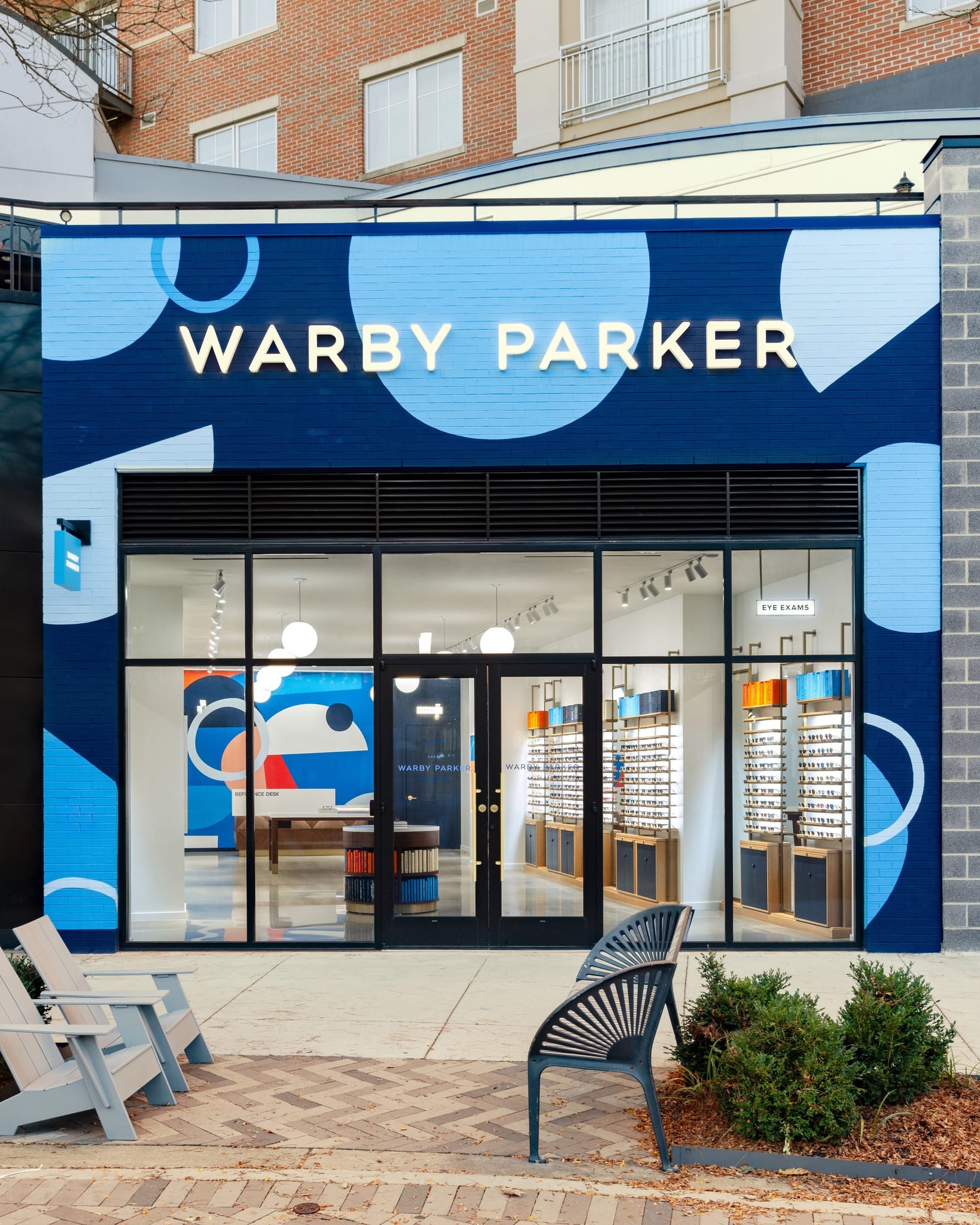
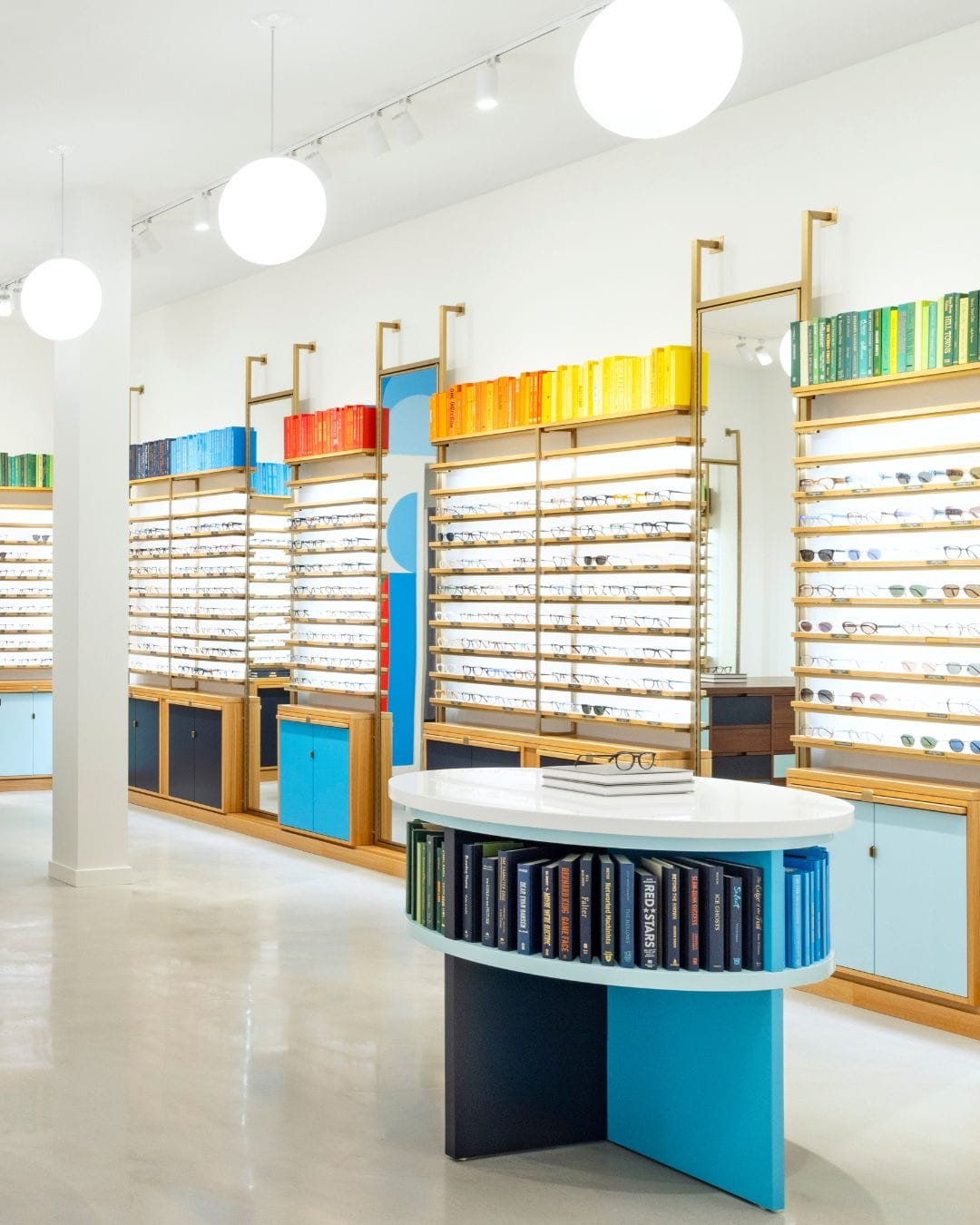
Industry & Market Analysis
Warby Parker operates in the broad eyewear industry, which encompasses prescription eyeglasses, sunglasses, and contact lenses, as well as related eye exams and accessories.
This is a large and growing global market. Globally, the eyewear market was estimated at around $200 billion in 2024 and is expected to reach ~$222B in 2025, growing at roughly 6–7% CAGR through the decade.
The U.S. market (Warby Parker’s primary focus) was about $38 billion in 2023, with anticipated growth of ~7.4% annually through 2030 – faster than general retail, driven by both medical needs and fashion trends.
Market Drivers & Trends (Last 5–10 Years)
The eyewear market has evolved due to several major forces:
- Growing Vision Needs: An aging population and widespread screen use have led to a rise in vision correction needs. In the U.S., 191 million adults use some form of vision correction, with consumers replacing glasses roughly every two years. This ensures recurring demand.
- Eyewear as Fashion: Glasses are now seen as style statements. Millennials and Gen Z often own multiple pairs. Warby Parker capitalized by offering fashionable, affordable frames that encourage variety.
- Shift to E-Commerce: Online eyewear sales rose from under 3% a decade ago to about 22% by 2021, accelerated by the pandemic. Consumers now expect a hybrid model combining digital and retail.
- Industry Structure: While retail remains fragmented, EssilorLuxottica dominates manufacturing and distribution, holding ~39% U.S. market share. Warby Parker, with ~7% share in 2021, leads the disruptor class.
- Tech & Telehealth: Innovations like Virtual Try-On and online vision testing (e.g., Warby’s Prescription Check) have improved convenience. Smart glasses, like Warby’s 2025 pilot with Google, signal a future fusion of fashion and tech.
- Consumer Values: Shoppers increasingly demand transparency, value, and social impact. Warby’s flat pricing, carbon-neutral operations, and “Buy a Pair, Give a Pair” ethos resonate. Its in-network insurance acceptance also helps reach traditional buyers.
- Target Segments: Warby began with urban millennials but now serves a broad demographic, including kids and older adults via progressive lenses. Repeat buyers and contact lens customers are key for increasing lifetime value.
Competitive Landscape
Warby Parker competes with both dominant incumbents and online disruptors:
- EssilorLuxottica (LensCrafters, Pearle Vision, etc.): Holding ~39% of the U.S. eyewear market, EssilorLuxottica combines brand power (Ray-Ban, Oakley), extensive retail (1,000+ LensCrafters stores), and vertical control. Warby Parker undercuts its $300+ average price with $95–$145 frames and a modern brand image. But Warby lacks designer licensing and has a smaller frame catalog. Notably, it still sources some lenses from Essilor, creating a complex dynamic of dependency and rivalry.
- Zenni Optical: The low-cost online leader, Zenni sells glasses starting at $6.95 and owns its factory in China. It serves price-sensitive consumers and had ~$500M in 2023 revenue. While Zenni offers unmatched prices and 3,000+ SKUs, it lacks physical stores and has limited service. Warby targets a “premium affordable” niche with better in-store and customer experience.
- EyeBuyDirect (owned by EssilorLuxottica): A fast-growing online competitor with prices in the $30–$100 range, EBD benefits from Essilor’s supply chain. Though it lacks Warby’s brand appeal or retail footprint, it’s growing fast in the e-commerce segment and competes on speed and price.
- National Vision (America’s Best): With 1,300+ stores and ultra-low pricing (e.g., 2 pairs + exam for $79), National Vision captures the in-person budget market. Warby competes on quality, experience, and design but cannot match the lowest price points. National Vision’s insurance inclusion also gives it an edge with price-sensitive customers.
- Other Players: Online sellers like GlassesUSA and niche brands like Ace & Tate or Krewe add competition, as do contact lens leaders like 1-800 Contacts. Warby’s move into contacts means it now competes on that front too, with convenience as a key selling point.
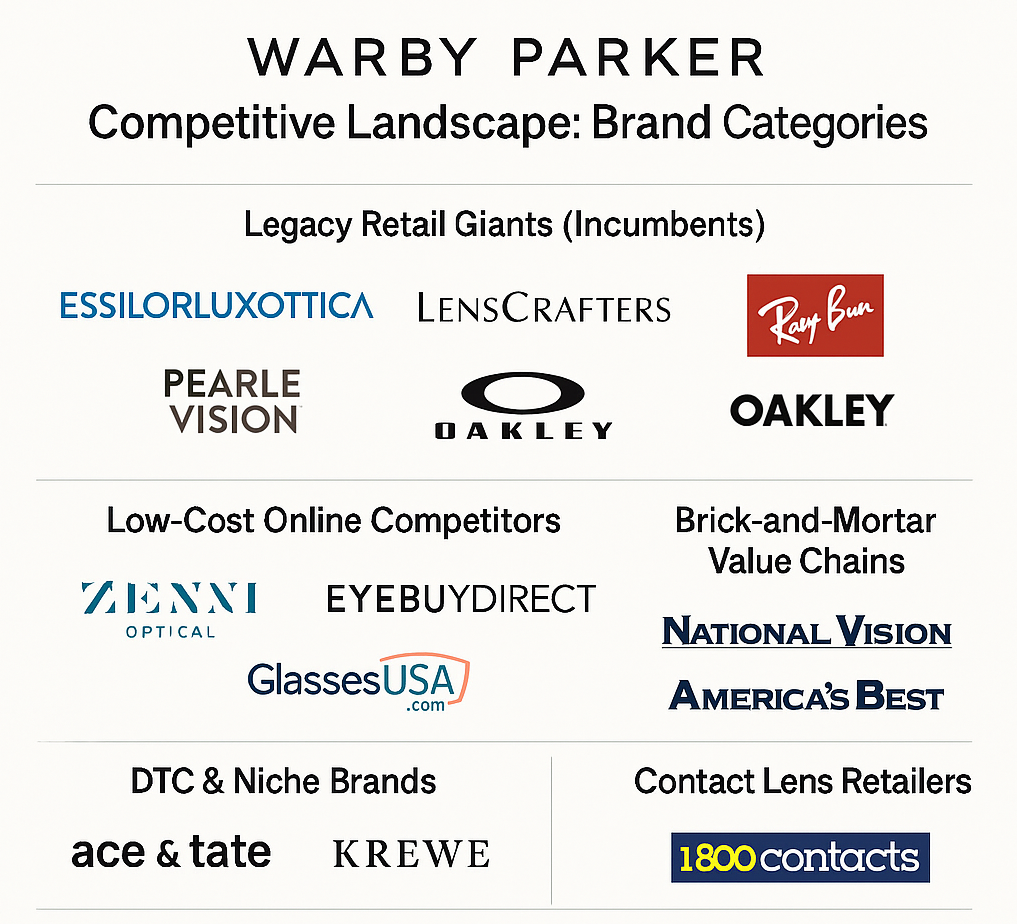
Warby Parker’s key advantages include a strong brand image (trendy, ethical, customer-focused), vertical integration (allowing quality at lower prices), and a successful omnichannel model that blends online ease with retail experience.
Its public benefit corporation status further appeals to values-driven consumers, and high customer loyalty is reflected in strong NPS and repeat purchases.
However, Warby faces constraints. It lacks luxury and sports frame offerings, cannot match ultra-budget players like Zenni on price, and operates at a smaller scale than giants like EssilorLuxottica. Expanding retail also adds operational complexity and overhead, with SG&A expenses reaching ~65% of revenue in 2023.
SWOT analysis
Strengths
Warby Parker has built a powerful brand with strong customer loyalty. Its vertically integrated model enables solid gross margins (55–60%) while keeping prices lower than traditional retailers.
The company excels in digital innovation, offering AR Try-On and online prescription renewal, and operates across both digital and physical channels with over 275 stores. Its social mission, more than 15 million pairs donated, further boosts brand equity and trust.
Weaknesses
Despite steady growth, the company is not yet consistently profitable, signaling ongoing margin pressure and high operating costs. Its product line is limited to Warby-designed frames, which may deter customers seeking luxury logos or specialized styles.
It also lacks presence in categories like sports eyewear, safety glasses, or bifocals for seniors. Finally, while Warby has global brand recognition, it generates nearly all its revenue from North America—a potential constraint if U.S. market growth slows.
Threats
Warby Parker faces pressure from both ends of the market. Incumbents like EssilorLuxottica have scale and influence, including through insurance networks that could steer customers away.
On the other side, budget players like Zenni Optical could lure price-sensitive shoppers, especially if their quality and service improve. Economic downturns present a risk, as consumers may delay purchases or choose lower-cost alternatives.
Regulatory changes, such as tighter telehealth rules, could also impact services like online vision testing. As a public company, Warby must also navigate investor scrutiny and potential volatility if it misses performance targets.
Warby Parker’s Impact
Warby Parker has integrated social impact into its business model from the beginning. Through its Buy a Pair, Give a Pair program, the company has provided more than 20 million pairs of glasses to people in need across over 80 countries.
Each customer purchase helps fund a pair of glasses for someone who lacks access to vision care, often in partnership with organizations such as VisionSpring, RestoringVision, and Ver Bien.
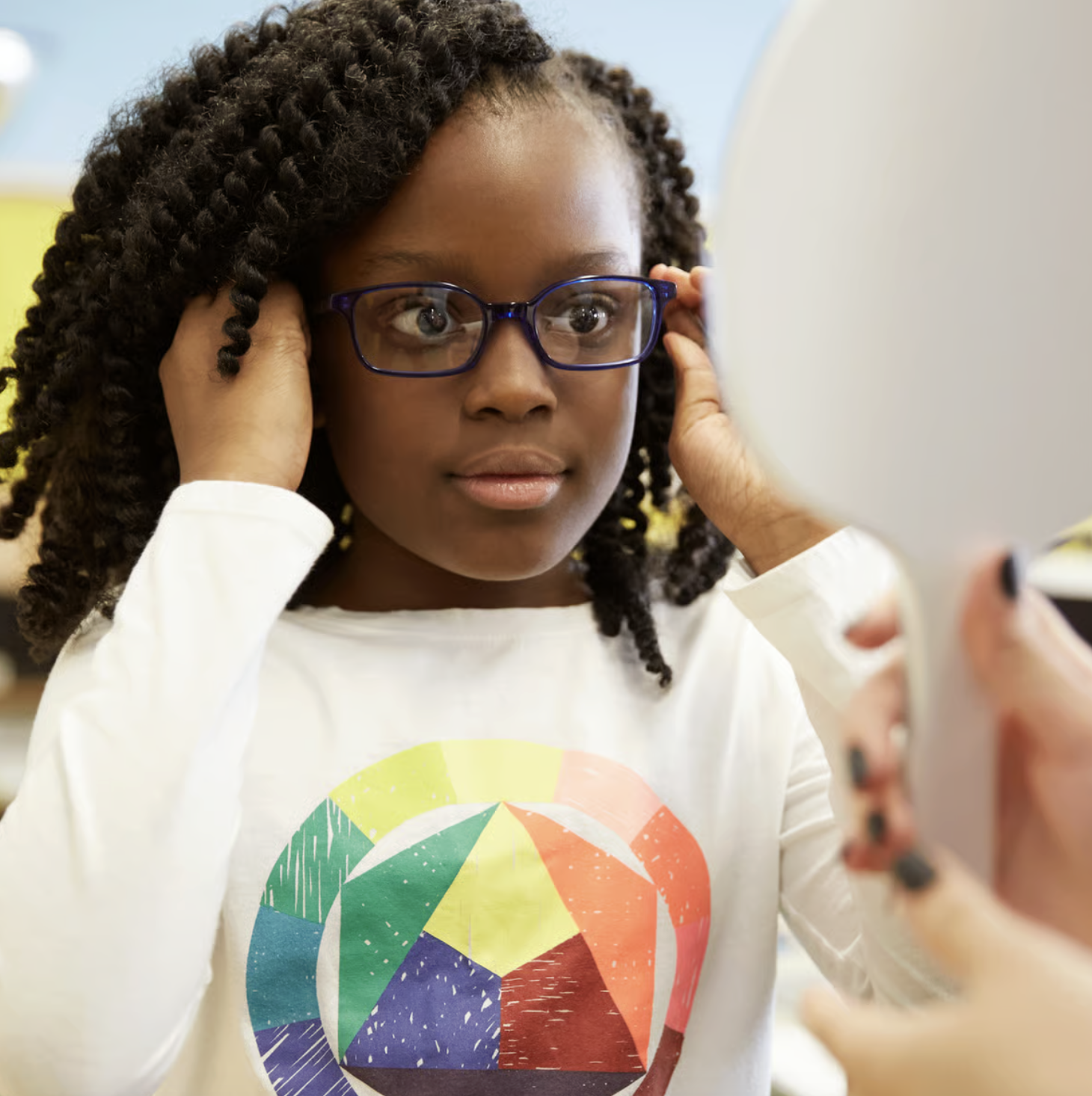
Understanding the transformative power of clear vision, Warby Parker created the Pupils Project to offer free vision screenings, eye exams, and prescription glasses to schoolchildren in the United States.
This initiative has reached nearly 300,000 students, helping improve academic performance and reduce barriers to learning.
Business Model & Revenue Streams
Warby Parker follows a vertically integrated, direct-to-consumer model, designing and selling its own eyewear through online and physical channels. This allows it to offer lower prices while capturing strong gross margins (typically 55–60%).
Eyeglasses
The core business is prescription glasses, with frames starting at $95 and premium styles reaching up to $375. Progressives and upgraded lenses increase average revenue per customer, which rose from $263 in 2022 to $287 in 2023. All frames are Warby-branded.
Contact Lenses
Since 2019, Warby sells both its own brand (Scout) and third-party lenses. Contacts accounted for about 7–10% of revenue by 2023. They offer recurring revenue potential through auto-refill programs and drive higher lifetime value per customer.
Eye Exams & Services
Stores with in-house optometrists offer eye exams (around $75), which made up ~3% of 2022 revenue. The company also provides telehealth services like its Virtual Vision Test. These services support retail sales and enhance customer convenience.
Sales Channels
About two-thirds of revenue now comes from retail stores, and one-third from e-commerce. The channels are complementary, stores often drive online engagement through services like Home Try-On and in-person fittings.
Customer Economics
Warby’s model is efficient. CAC has remained relatively low (under $40), while customer lifetime value is high due to repeat purchases and product add-ons. Around 50% of customers return for additional purchases. By late 2023, Warby Parker had 2.33 million active customers, with growth increasingly driven by existing buyers.
Recurring Revenue
While glasses aren’t on a subscription model, customers tend to return every 1–2 years. Contact lenses and auto-refill programs add true recurring income. The company has piloted programs like annual eye exam memberships to drive retention.
Other Revenue & Costs
Other revenue includes accessories, gift cards, and minor service fees. Warby’s largest costs are store operations, SG&A, and marketing. Despite high operating expenses, store-level economics are strong, with typical payback in under two years. Adjusted EBITDA margin reached 7.8% in 2023.
In summary, Warby Parker’s business model is about maximizing lifetime value of customers by serving all their vision needs directly.
The revenue stream breakdown: glasses ~85%, contacts ~7-10%, exams ~3%, accessories ~1-2%.
A key feature of the model is that one customer often contributes to multiple streams (e.g., gets an exam, buys glasses, later buys contacts – all through Warby).
This integrated approach, along with efficient customer acquisition, underpins Warby Parker’s ability to generate growth and move toward profitability.
The model has proven that it can scale (with revenue nearly $800M and growing), and if current trends continue, Warby Parker should soon generate steady positive net income, validating the DTC eyewear model financially.
Financial Performance
Revenue Growth
Warby Parker’s revenue grew from $273M in 2018 to $771M in 2024, a ~20% CAGR. Growth was fastest from 2018–2021, rebounded post-COVID, and has remained in the low double digits since.
In 2023, revenue rose 12% to $669.8M, driven by higher spend per customer and store expansion. In 2024, it exceeded guidance, reaching $771.3M (+15%).
Profitability & Margins
The company has yet to post annual net profits but is trending positively.
- Net loss improved from -$110M in 2022 to -$63M in 2023, and to ~-$20M in 2024.
- Gross margin held between 54–57%, dipping due to higher contact lens sales and store costs.
- Adjusted EBITDA rose to $52.4M in 2023 (7.8% margin), showing improved efficiency.
- Operating cash flow turned positive in 2023 ($61M), with $7.3M in free cash flow.
Cost Management
SG&A as a % of revenue is falling: 70%+ in 2021 to ~53.5% adjusted in 2023. Store economics are strong, with quick payback. Warby Parker is reducing reliance on paid digital ads and gaining scale efficiencies.
Balance Sheet
As of late 2023, Warby Parker had $216.9M in cash, no debt, and access to a $120M credit line, allowing it to fund store growth without dilution.
Stock Performance
Warby Parker is evolving from a high-growth DTC startup to a sustainable, profitable retail brand. With strong unit economics, a solid balance sheet, and improving margins, it's on track to reach full-year profitability by 2025 or 2026.
Go-to-Market & Marketing Strategy
Warby Parker combines digital, physical, and brand-driven tactics to acquire and retain customers. From the start, it focused on selling a lifestyle and experience—not just eyewear.
Direct-to-Consumer Focus:
Warby sells exclusively through its own channels, website, app, and branded stores—to control brand experience and margins.
Stores also act as marketing assets: located in high-traffic areas, they double as showrooms and billboards, often generating online sales through in-person exposure.
Digital & Content Marketing:
Early growth came from earned media and viral buzz. As it scaled, Warby used paid digital ads (Google, Meta), retargeting, email campaigns, and witty social media to maintain momentum.
Content like the #warbyhometryon trend turned customers into informal brand ambassadors. In recent years, they reduced ad spend in favor of store expansion due to better ROI.
Referral & Influencer Tactics:
Customer referrals, influencer reviews, and user-generated content have been essential. Referral programs and organic word-of-mouth remain strong drivers thanks to high satisfaction.
PR & Brand Storytelling:
Founding narrative, social impact (B Corp), and playful campaigns (e.g., “Warby Barker” for dogs) drive PR coverage. Annual impact reports and surprise stunts keep the brand culturally relevant.
Creative Partnerships & Community Events:
Warby collaborates with brands (e.g., Arby’s, Ace Hotel) and hosts in-store events that blend culture, books, and local flavor—reinforcing lifestyle branding.
Retention & Customer Experience:
Customer service is a major retention lever: fast support, generous return policies, and smart CRM (like personalized frame suggestions) drive repeat purchases and loyalty. The app enhances the experience with tools like Virtual Try-On and vision reminders.
Warby Parker’s strategy mixes digital efficiency, engaging brand voice, physical presence, and customer delight to drive low-CAC, high-retention growth.
Their marketing spend (~10–15% of revenue) is lower than peers, thanks to organic momentum and a highly referable customer base.
Operations & Organizational Structure
Warby Parker runs a vertically integrated operation that spans design, supply chain, retail, and customer support, ensuring quality control and customer experience across every touchpoint.
Design & Manufacturing:
Frames are designed in-house in NYC and produced by overseas partners in China, Japan, and Italy. Warby controls materials (e.g., custom acetates) and uses its own optical labs in New York and Las Vegas to edge lenses and assemble glasses—allowing for faster turnaround and cost savings.
Labs & Supply Chain:
Its two U.S. labs handle over half of all orders, providing in-house lens cutting, assembly, and QC. Warby uses lean manufacturing principles and strategically located facilities to reduce shipping times and boost capacity. Orders are routed based on proximity and load.
Inventory & Fulfillment:
Warby manages hundreds of SKUs with centralized and store-level inventory, supported by proprietary software that integrates e-commerce and retail. The Home Try-On program has its own inventory pool. All logistics are optimized for speed and visibility across channels.
Retail Operations:
Stores act as both showrooms and service centers. Each has trained advisors and often optometrists. Store locations are chosen based on e-commerce data and high foot traffic. The company’s unified systems allow for seamless ordering, in-store service, and inventory visibility.
Customer Support:
A centralized team (largely in Nashville and Las Vegas) handles calls, chat, and emails with fast, personalized responses. Warby uses internal CRM tools to offer contextual support and coordinates closely with labs and stores to resolve issues quickly.
Technology Backbone:
Warby has built its own POS, inventory, lab management, and appointment systems. The app supports Virtual Try-On, vision tests, and shopping. Integrated tech ensures omnichannel consistency, from browsing to delivery.
Org Structure & Culture:
Co-CEOs lead a lean team across design, retail, tech, marketing, and impact. With ~3,800 employees, Warby fosters a startup-style culture, offering equity to many team members and promoting transparency and feedback loops from store floors to HQ.
Summary:
Warby Parker’s operational strength lies in its hybrid manufacturing model, custom tech stack, and human-centered culture, delivering efficiency, flexibility, and brand consistency at scale.
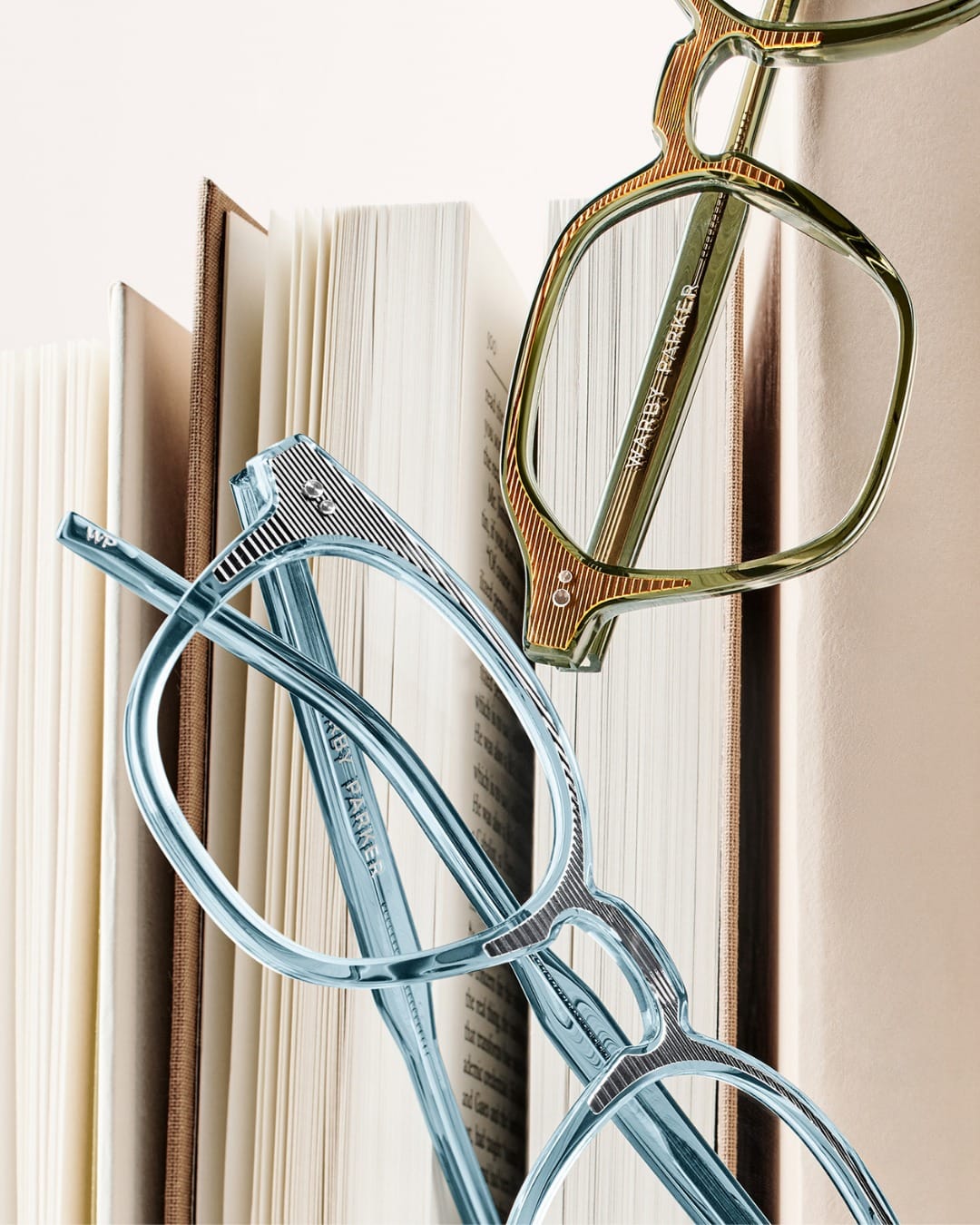
Challenges & Crisis Management
Warby Parker has faced rapid growth, legal disputes, a global pandemic, and public market pressure, consistently responding with agility and a customer-first mindset.
Early Demand & Growth Pains (2010–2012):
Soon after launch, overwhelming demand led to stock-outs and long waitlists. Instead of losing trust, the founders turned this into a brand-building moment—personally updating customers, offering in-home try-ons, and scaling operations quickly.
This set the tone for Warby’s high-touch service ethos.
Competitive Pressures & Legal Disputes:
Entering a market dominated by EssilorLuxottica, Warby built its own brand, supply chain, and retail footprint to stay independent.
It successfully defended itself against lawsuits (e.g., from 1-800 Contacts over search ads), reinforcing its right to compete. Rather than match prices with Zenni or LensCrafters, Warby leaned into experience, quality, and affordability.
COVID-19 Response (2020):
Store closures threatened Warby’s biggest growth channel. The company pivoted quickly promoting e-commerce, virtual try-ons, and tele-optometry.
It produced and donated PPE, maintained employee benefits during furloughs, and added safety measures across operations. Revenue still grew in 2020, proving the strength of its omnichannel model.
Post-IPO Profit Pressure (2022–2023):
After going public, Warby shifted from “growth-first” to “sustainable growth.” It cut back on digital ad spend, improved operational efficiency, and introduced higher-priced frames to raise AOV.
Adjusted EBITDA margins rose, net losses shrank, and investors gained confidence in the business model’s long-term viability.
Reputation & PR Handling:
From criticism over its vision test app to social media complaints, Warby responded quickly and transparently.
It clarified medical disclaimers, obtained regulatory clearance, and maintained its customer-focused brand voice—often turning complaints into loyalty moments.
Conclusion:
In every crisis, Warby Parker has emphasized transparency, fast adaptation, and values-driven decisions. These responses not only resolved issues but often strengthened customer trust, operational resilience, and investor confidence.
Strategic Initiatives & Future Outlook
Omnichannel Expansion:
Warby Parker aims to scale to 900 stores, expanding in key U.S. markets and potentially launching internationally (Canada, U.K., Australia). More stores drive both direct sales and online traffic.
They’re also adding eye exams to all locations, boosting customer value and health services. Stores typically break even within 20 months, making this a profitable growth lever.
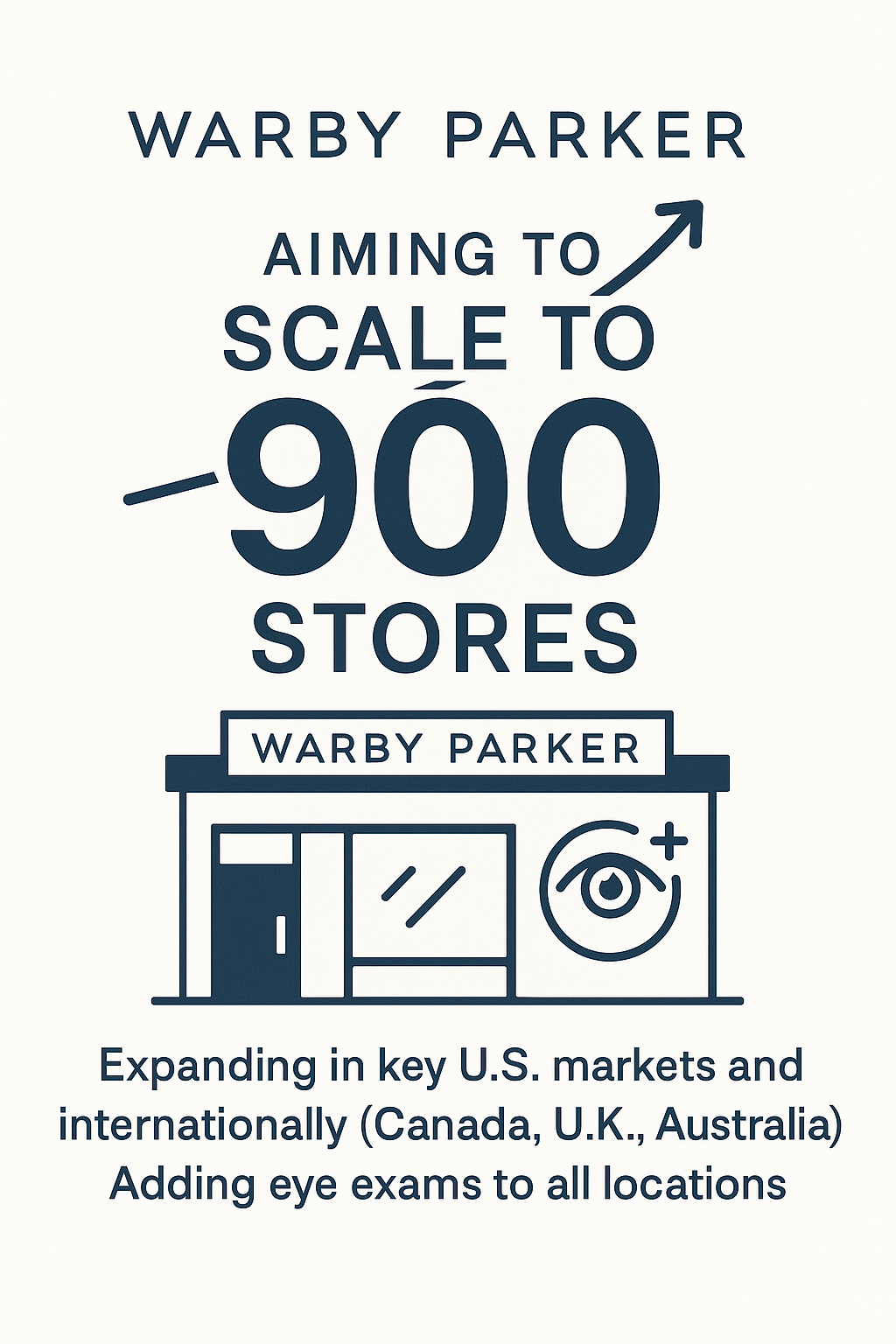
Insurance Integration:
The company is moving in-network with major vision insurers like MetLife and UnitedHealthcare, unlocking access for tens of millions. A VSP partnership would be a major breakthrough. Warby could also explore launching its own vision plan or subscription model, providing coverage for exams and eyewear directly.
Product Innovation:
Partnerships like Google (smart glasses) signal interest in AR eyewear. Other areas for growth include kids' frames, prescription safety glasses, contact lenses (via its Scout brand), and vision tech (e.g., upgraded Virtual Vision Test). Warby may also introduce in-store devices or AI screening to boost exam throughput.
Global Expansion:
After establishing stores in Canada, Warby may test other international markets (e.g., U.K. or Europe) via pop-ups or localized e-commerce. Challenges like regulations and logistics remain, but global demand for affordable, stylish eyewear is strong.
Improving Profitability:
Warby is optimizing labs, supply chain, and store rollouts to enhance margins. They may adopt automation, near-shore frame production, and smaller-format stores. Training programs ensure staff scalability, especially as services like exams grow.
Mission & Impact:
Warby Parker continues to scale its “Buy a Pair, Give a Pair” program and may aim for 50 million donations by 2030. Sustainability initiatives could include eco-friendly frames and carbon reduction efforts in labs and shipping.
Recommendations
- Test International Markets through localized online sales and flagship stores (e.g., U.K.)
- Leverage AI for Personalization, recommending frames based on user preferences and behavior
- Expand into Services, such as contact lens subscriptions or branded insurance offerings
- Invest in AR/VR, exploring virtual stores or AR try-ons to maintain tech leadership
- Preserve Culture at Scale via standardized training and leadership development programs
Outlook
Warby Parker is positioned to become a major player in vision care. With strong retail and digital synergy, expanding insurance coverage, and product diversification, it can evolve from a DTC disruptor into a full-service optical leader.
If it executes with focus and continues delivering standout customer experiences, Warby could reach 600+ stores and multi-billion-dollar revenue by 2030, proving that scale and purpose can go hand in hand.
Key Takeaways from Warby Parker’s Journey
1. Purpose Drives Loyalty
Warby Parker proved that aligning business with mission can be a powerful differentiator. Its “Buy a Pair, Give a Pair” model helped build a brand customers and employees feel good about supporting.
2. Customer Experience is a Growth Engine
Delighting customers with free try-ons, easy returns, and standout service turned them into loyal advocates. Prioritizing satisfaction helped Warby grow with minimal advertising.
3. Omnichannel is Essential
By blending online ease with in-store experiences, Warby created a seamless shopping journey. Its stores boost online sales and act as brand hubs—proving physical retail is still relevant.
4. Keep Innovating
From AR try-ons to eye exam apps and contact lenses, Warby never stopped iterating. The company embraces risk and rapid testing, staying ahead of disruption.
5. Scale Sustainably
Warby adapted to shifting market conditions, balancing growth with profitability. Its ability to pivot, while staying true to its mission—has made it both resilient and investor-friendly.
Final Lesson:
Warby Parker is a modern blueprint for purpose-driven business. It shows that doing good and doing well aren’t mutually exclusive and that bold vision, smart execution, and customer obsession can disrupt even the most entrenched industries.







